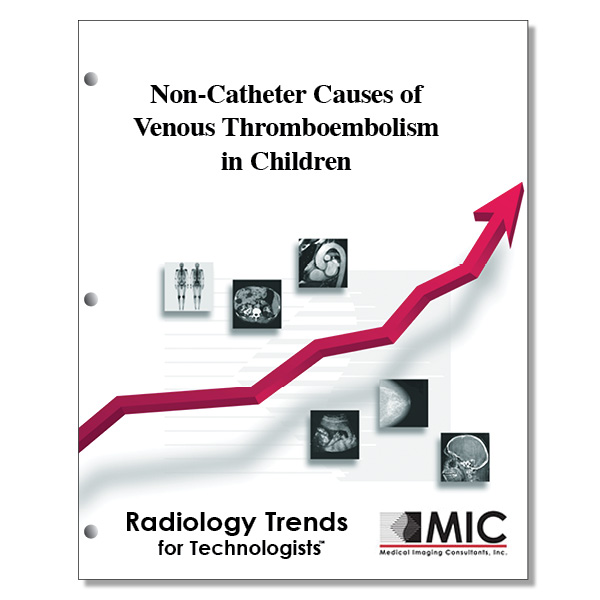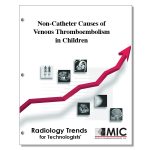

Non-Catheter Causes of Venous Thromboembolism in Children
A review of the common causes of venous thromboembolism in children – other than those related to a central venous catheter.
Course ID: Q00568 Category: Radiology Trends for Technologists Modalities: CT, MRI, Radiography, Vascular Interventional3.0 |
Satisfaction Guarantee |
$34.00
- Targeted CE
- Outline
- Objectives
Targeted CE per ARRT’s Discipline, Category, and Subcategory classification:
[Note: Discipline-specific Targeted CE credits may be less than the total Category A credits approved for this course.]
Computed Tomography: 1.75
Procedures: 1.75
Head, Spine, and Musculoskeletal: 0.50
Neck and Chest: 0.50
Abdomen and Pelvis: 0.75
Magnetic Resonance Imaging: 1.00
Procedures: 1.00
Neurological: 0.25
Body: 0.50
Musculoskeletal: 0.25
Registered Radiologist Assistant: 3.00
Procedures: 3.00
Neurological, Vascular, and Lymphatic Sections: 3.00
Sonography: 1.00
Procedures: 1.00
Abdomen: 0.25
Superficial Structures and Other Sonographic Procedures: 0.75
Vascular Sonography: 0.75
Procedures: 0.75
Abdominal/Pelvic Vasculature: 0.25
Venous Peripheral Vasculature: 0.25
Extracranial Cerebral Vasculature and Other Sonographic Procedures: 0.25
Outline
- Introduction
- Head and Neck
- Dural Venous Sinus and Cerebral Venous Sinus Thrombosis
- Cavernous Sinus and Superior Ophthalmic Venous Thrombophlebitis
- Lemierre Syndrome
- Upper Extremity and Thorax
- Paget-Schroetter Syndrome
- Superior Vena Cava Syndrome
- Pulmonary Embolism
- Abdomen and Pelvis
- Portal Venous Thrombosis
- Superior Mesenteric Venous Thrombosis
- Budd-Chiari Syndrome
- Splenic Venous Thrombosis
- Renal Venous Thrombosis
- May-Thurner Syndrome
- Lower Extremity
- Tumor-related Venous Thrombosis
- Follow-up Imaging of VTE
- Conclusion
Objectives
Upon completion of this course, students will:
- recall the prevalence of venous thrombosis in hospital admissions of children
- list the non-catheter cause of venous thromboembolism in children
- list the concerns associated with CT in the diagnosis of venous thromboembolism
- outline reasons that MR imaging is less commonly used for the routine diagnosis of venous thromboembolism in children
- recall the prevalence of pediatric stroke
- state when the presence of cerebral venous sinus thrombosis is highest
- differentiate between symptoms of cerebral venous sinus thrombosis in older children and neonates
- list the infectious causes of cerebral venous sinus thrombosis
- choose the imaging test of choice for suspected cerebral venous sinus thrombosis in children
- list parenchymal changes secondary to cerebral venous sinus thrombosis
- state the treatment of choice for cerebral venous sinus thrombosis in children
- list the imaging interpretation pitfalls associated with cerebral venous sinus thrombosis in children
- list the clinical presentations for septic thrombophlebitis of the cavernous sinus
- list the symptoms of Lemierre syndrome
- state the approximate mortality rate associated with Lemierre syndrome
- recall the location of the costoclavicular space
- list the anatomy that borders the costoclavicular space
- recall the extremity affected by Paget-Schroetter syndrome
- choose the initial test of choice for pediatric patients suspected of having Paget-Schroetter syndrome
- recall the most feared complication of venous thoracic outlet syndrome
- list the causes of superior vena cava syndrome
- state the mortality rate for pulmonary embolism in children
- list symptoms of pulmonary embolism
- recall the imaging test of choice for patients with respiratory symptoms suspected of having pulmonary embolism
- cite the advantages of CT angiography of the pulmonary arteries in children
- list the imaging findings of prognostic value in acute pulmonary embolism
- state the most common period of development when portal venous thrombosis is found
- list the clinically most common indications for ultrasound performed in neonates with portal venous thrombosis
- list the most common complications of neonatal portal venous thrombosis
- recall the imaging modality of choice for the diagnosis of portal venous thrombosis
- state the imaging modality that is not sensitive for diagnosis of superior mesenteric venous thrombosis
- name the most feared complication of mesenteric venous thrombosis
- provide the alternative name for Budd-Chiari syndrome
- list the symptoms of Budd-Chiari syndrome
- state the first imaging study usually ordered in patients suspected of having Budd-Chiari syndrome
- list the most common causes of acute pancreatitis in children
- recall the patient population in which pediatric renal venous thrombosis in most common
- identify the patient population where May-Thurner syndrome is most common
- choose the best initial test for diagnosis of deep venous thrombosis in children
- list the scenarios that could occur after development of venous thrombosis
